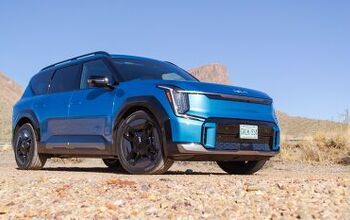Mysterious, Unfixable 'Chevy Shake' Affecting Pickup Trucks Too

Looking at buying a Chevy Silverado or GMC Sierra? You may be in for a turbulent ride.
GM engineers can’t seem to pinpoint the cause of a mysterious recurring issue in vehicles riding on GM’s K2XX platform, which includes its full-size trucks and SUVs, a problem that was referred to by one dealer as “The Chevy Shake.” Because GM can’t isolate the cause of the problem, a permanent fix has also been elusive.
Get the Flash Player to see this player.
In December, AutoGuide.com ran a report detailing buffeting and vibration issues found in some GM full-size SUVs after being contacted by an owner who was experiencing these problems. While investigating the SUV issue, another flaw with different GM vehicles surfaced repeatedly in online forums and in the National Highway Traffic Safety Administration’s complaints sections: vibrations from the 2014 and 2015 Chevy Silverado and GMC Sierra.
ALSO SEE: There’s a Big Issue with GM’s SUVs and No One Seems to Have a Solution
Customer Complaints
While SUV owners complain of buffeting causing headaches and dizziness, GM half-ton owners claim there is an insistent vibration in their trucks. “While driving at speeds above 45 mph, there is a vibration from the rear of the vehicle,” reads a complaint on the NHTSA database. “Dealer advised it was wheel balance and balanced the tires with no relief. Have since replaced all four tires with no relief.”
In total, there are 301 complaints on the NHTSA database concerning 2014 – 2015 Chevy Silverados and GMC Sierras, 31 of which are about the vibration, which equates to about 10 percent. There are no complaints regarding the 2016 model year trucks yet on the NHTSA database.
“The vehicle has an established, measurable and documented vibration problem that randomly increases and decreases in applitude (sic) and frequency at all speeds,” reads a NHTSA complaint. “GM is unable to resolve after 12 dealer attempts to address, including multiple sets of tires, rear differential, drive shafts and shock absorbers all failing to resolve the issue. GM stated vibration is inherent to the design and no further action needed or will be taken ever for vibration.”
Exactly like with the SUVs, a number of different fixes have been attempted according to these complaints, the most common being balancing of wheels and replacement tires. Also just like with the SUV issue, sometimes owners report that swapping the tires fixed the problem, while some say that no amount of dealership visits has improved the situation.
“Since about 15,000-18,000 miles, this truck vibrates at most speeds, most noticeable at 65 mph and over,” reads another complaint on the NHTSA database. “It is at the dealer for the second time. The first time all they did was balance the tires, but the problem didn’t go away. The dealer is still scratching their heads on this. The loaner 2015 I have is worse and vibrates at all speeds.”
Also like the SUV issue, there are a fair amount of forum users who report having no issue at all with their trucks, and once again, AutoGuide.com must point out that we have never felt abnormal vibrations in a General Motors pickup truck, and we have been in dozens of them.
Still, the outpouring of complaints across a variety of Internet platforms makes the problem hard to ignore.
We spoke with one Chevy customer, Nicholas Maratea, who purchased a 2014 Silverado High Country Crew Cab with the 5.3-liter V8 and 20-inch wheels on October 23, 2014. On a warm day in late February, Maratea noticed a shaking that he said “feels like driving on cobblestones,” at around 77 mph.
Maratea brought his truck into his service manager, where a long list of repairs was performed. First it was four new tires, which did not help. Then the truck was left behind for a week and the ring and pinion gears were changed. After that didn’t help, the truck stayed at the dealership for 20 days and received another set of tires and new ring pinion gears along with a road force balancing.
At this point, Maratea says the truck did not vibrate for roughly 50 miles before the issue returned. He also noticed that one of his wheels had 24 wheel weights on it, a number much higher than normal. Two new shocks and an entire rear axle later, the truck was still shaking and a GM engineer was brought in to take the truck for a seven-day period.
At this point, GM agreed to buy back Maratea’s truck in exchange for a new one. Maratea ended up in a 2015 Silverado, which he says also has a very mild vibration.
Another GM pickup owner reached out by e-mail to share his story. “I am on my second truck with the issue. The first one spent 56 days of its first 6 months in the shop,” wrote Evan R. “They checked runout on all parts and deemed them in spec and kept replacing tires. Four sets of different brand tires and two sets of wheels and it still shook over 70 mph.”
AutoGuide.com’s own forum for the Chevy Silverado and GMC Sierra have a number of threads full of customers who have stories that sound exactly like Maratea’s. In this thread, user pauly1119 says that three new sets of tires and three attempts to road force balance the truck didn’t help the vibration, while all of the 2016 model year loaners they drove also vibrated.
A quick YouTube search of “Silverado vibrations” turns up numerous videos that document the issue, with many owners filming water bottles or change to show exactly how much their trucks vibrate.
Get the Flash Player to see this player.
One thread on gm-trucks.com contains over 560 pages all dedicated to the vibration.
What We Know About the Fix
Though many customers claim that their dealers have told them that the “truck is operating normally,” General Motors does acknowledge that there is a problem. In fact, it knows about a number of problems with its trucks.
A preliminary service bulletin has been issued, arming GM technicians with the information that GM engineering has on the vibration issue. Dated August 14, 2015, PI1354C extensively details all of the different processes that should be undertaken to try and fix the truck when a customer complains of vibration. AutoGuide.com obtained the bulletin through a GM technician.
“The purpose of this bulletin is to outline the recommendations and procedures for diagnosing and repairing vibrations caused by wheel and tire, axle components and/or propeller shafts,” the bulletin begins.
A GM technician’s first job is to go for a road test and use a device known as a PicoScope to detect vibrations and frequencies in the truck. After an on-road reading is finished, the technician is instructed to put the truck on jack stands or a hoist, remove the wheels and run it back up to the same speed it was vibrating at on the road with the PicoScope still attached. If the vibration is still present, the issue is in the powertrain or body, if the vibration is gone, it is a wheel or tire issue.
Once the vibration is found, there are six different separate problem categories it can fall into:
- 1st Order Tire (Freq 11-14 hz at 60 mph)
- 1st Order Prop Shaft (Freq 38-44 hz at 60 mph)
- 2nd Order Prop Shaft (Normally a launch shudder or left under hard acceleration)
- 3rd Order Tire Combined with 1st Order Prop (Creates a phasing boom)
- Vibration Felt in Four-Cylinder Mode (V6 only)
- Vibration Felt at Idle
Each of these conditions has a different set of supposed fixes, that mostly start with road force balancing but can also include the re-tightening of body mounts, correcting pitchline runout, correcting driveline angles, replacing driveshafts, inspecting the ring and pinion gears for issues and more.
Download Bulletin PI1354C Right Here
In the bulletin, GM says that there have been “many cases” of dented driveshafts, yet another possible cause for the vibration.
And after all that work is performed, the truck still might not be fixed. “Once all areas of vibrations has been reduced, if there is still vibration that the customer is concerned about, the following diagnosis maybe helpful to determine if a shock issue exists,” reads the bulletin.
The “shock issue,” is that some shocks used on Z71-trim pickup trucks were made with contaminated shock oil, causing them to dampen incorrectly. GM says that these shocks do not cause the vibration, but if the truck is vibrating, it only makes it worse. The contaminated units were all produced before May 27, 2014, which means only early model year 2014 trucks will have them.
What is GM Saying About This?
We asked General Motors if they could provide us with more information on the truck vibrations.
“GM is aware of customer concerns regarding a buffeting noise in certain full-size trucks,” said Nick Richards, GM product development communications manager in a response to our query. “GM does not believe this is a safety issue. Customer satisfaction is our top priority and any customers with a vehicle exhibiting these conditions should visit their GM dealer for vehicle inspection and potential repair under warranty.”
So What’s the Answer?
Unless it is deemed a safety issue, GM is not obligated to recall the trucks. And the detailed information bulletin shows that the brand is working to correct the problem.
But until the root cause of the Chevy shake can be pinpointed, owners of these pickup trucks will have to continue driving their vibrating pickups and deal with seemingly endless visits to the shop.
Become an AutoGuide insider. Get the latest from the automotive world first by subscribing to our newsletter here.
Discuss this story our GM Trucks Forum

Stephen covers all of the day-to-day events of the industry as the News Editor at AutoGuide, along with being the AG truck expert. His truck knowledge comes from working long days on the woodlot with pickups and driving straight trucks professionally. When not at his desk, Steve can be found playing his bass or riding his snowmobile or Sea-Doo. Find Stephen on <A title="@Selmer07 on Twitter" href="http://www.twitter.com/selmer07">Twitter</A> and <A title="Stephen on Google+" href="http://plus.google.com/117833131531784822251?rel=author">Google+</A>
More by Stephen Elmer












































Comments
Join the conversation
I have a 2018 Silverado Texas edition that has been shaking and vibrating since the first week of our ownership. I bought it new and for the first few months I actually thought it was the roads. It is my wife's truck, she rarely drives it, so it took us a while to realize it was the TRUCK and not the road! Even now, in 2022, the truck only has 12,368 miles. IMy wife complained via phone to the dealership, asked if they knew anything about this problem and was bold faced lied to-said they hadn't had any complaints of that nature! And of course by last November, 2021 my warranty was up...had expired in January of 2021. I am kicking myself for not being more aggressive, but with lock downs due to Covid since 2020, and my wife and I both getting Covid, we werent driving much at all, only to grocery store or doctor for past year and a half, and we usually went in my 2008 Silverado,left hers in carport covered. We googled the problem last year and hundreds if not thousands of complaints popped up! In frustration I went to dealership today and was told they knew about the problem, and they have a solution to fix it! I was so thrilled. The mechanic explained the transmission fluid was not the correct kind...said from day 1 the factory was putting wrong fluid in the trucks. So I wasted 3 hours of my time while they flushed and refilled the transmission fluid.The mechanic was kind, and really wanted to fix my problem. He took it out for the test drive after completing the job and returned it to me, assuring me he did not feel any shaking or vibrations. On my way home, the shaking was still there. Apparently the mechanic just drove it around town, didn't get it up to the speed that gets the shaking going... (usually over 40mph, but sometimes as low as 25) I pulled over on interstate, called the dealership, and I will be going back tomorrow! This is so frustrating, we live in a small rural community 40 miles away from dealership. I feel sorry for the mechanics who are trying to do a good job to fix a vehicle that in my opinion should be RECALLED! GM has known about this for years...they have no idea what to do to fix it. What a shame to pay almost $60,000 for something that is obviously defective. My wife wants to trade it in and buy a Ford or Toyota truck. That may happen. No more Chevrolet trucks for us! I will update this after my next 80 mile round trip so the mechanic can try something else...
I had the same shaking with my 2015 Silverado 3500 dually. It got so bad I had to start at the front of the truck an replaced the front and rear shocks, no go. I previously upgraded my saddle tank from a 32 gal to a 60 gal titan tank. Very happy with it. but when inspecting under the truck to try and solve the shaking issue, I noticed there was about a foot of shiny space on the rear of my drive shaft. I thought it was the tank being loose but no, it was fine. I read that the drive shafts could cause issues, but the u joints were fine. I ordered an after market drive shaft and replaced it as it was why out of balance at this point. Still was shaking So, after talking to my brother that had a similar issue and he had his bushings replaced and the shaking went away and it drove like a new truck again. I decided to replace the front end steering components with kryptonite parts. Still waiting on the parts to come in, the shaking was getting worse. Then looking at it again I noticed a line forming on the new drive shaft Did some research that led me to the rear spring pin bolts that had broken could cause the back end to move that much to cause the tank and drive shaft to touch. I ordered some 4k springs and had them installed. The shaking was gone, and the only thing left was what appeared to be the FrontEnd wear. I had the kryptonite parts installed and it is driving like a new truck again. No shake and the drive shaft is safe. lot of little things fixed, but the big one was the Leaf spring bolts. When I took it in to have them replaced, and showing the tech, the leaf springs had slid and were no longer aligned properly. Not saying this or any of this is your issue, but all the forums Ive read mentioned nothing about the rear leaf spring pin bolts breaking. Maybe this will help someone.